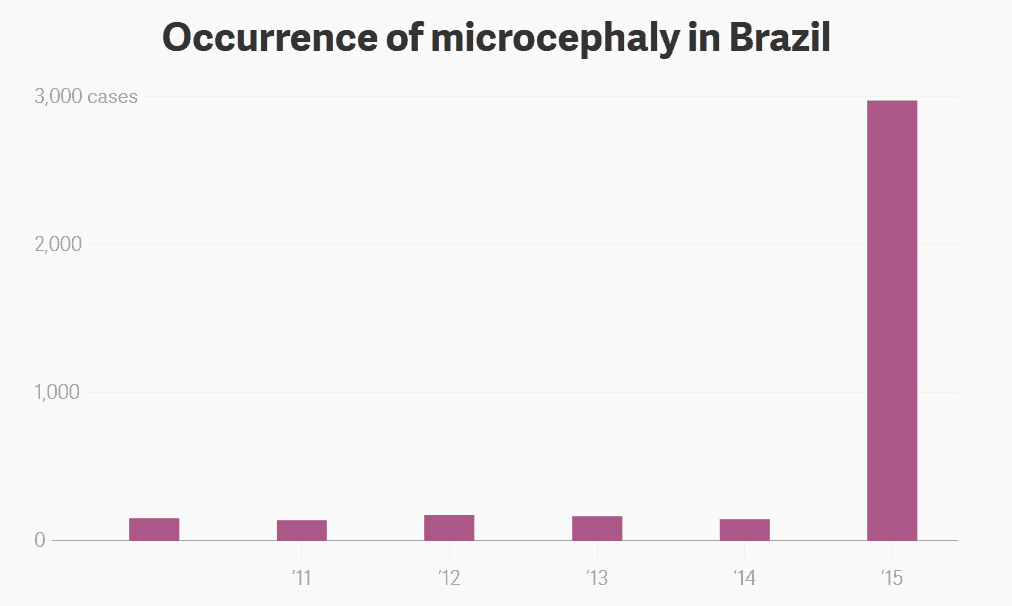Starting in 2014, the country of Brazil has seen a chilling increase in the number of babies born with microcephaly (a devastating neurological condition that causes abnormally small skulls and brains to develop). Since we’ve last talked about the Zika virus, the number of reported cases has risen to almost 3,000 (500 new cases since our first article). The government has also declared a state of national emergency in the most affected areas as scientists are scrambling to figure out why so many babies are born with this often lethal condition.
Their main suspect so far is Zika, a virus named after the Ugandan forest it was first identified in in 1940. The virus spreads through the bites of Aedes aegypti mosquitoes, and propagated like wildfire through the country in a recent epidemic. Recent government estimates place the number of infected at around 1.5 million locals.
Why wasn’t anything done to combat the virus up to now, you might ask. Well that’s because the worst symptoms Zika had thrown at us were itchy rashes, fever and conjunctivitis. In most cases those infected didn’t show any symptoms at all, and general scientific consensus was to refer to it as a “benign disease.”
But, much to the horror of expecting parents living in Brazil, it could be a completely different story for pregnant women; having identified the presence of Zika virus in the placentas of children born with microcephaly, researchers now have their sights squarely on the virus trying to understand how it can cause the condition.
“When the cases of microcephaly started to soar [in November 2015], doctors noticed they coincided with the appearance of the Zika virus in Brazil,” CNN reports.
“They soon discovered that most of the affected mothers reported having Zika-like symptoms during early pregnancy – mild fever, rash, and headaches.”
Most babies born with microcephaly die young. Those who survive have life-long cognitive impairment, and there is no cure for the condition. This is why Claudio Maierovitch, director of Brazil’s Health Ministry’s department of surveillance of communicable diseases has been urging women in the ares with highest infection rates to put planned pregnancies on hold if possible, The New York Times reports. Still, given how fast the virus is spreading throughout the country, containing Zika may be impossible.
“Brazil offers the ideal conditions for Zika to spread so quickly,” said Ana Maria Bispo de Filippis, lead researcher of the team that linked Zika to microcephaly.
The country also has “a susceptible population in which the majority of people never had contact with the disease,” she added.
The link between Zika and the condition is troublesome though — previous epidemics in Micronesia and French Polynesia didn’t lead to an increased number of cases of microcephaly. Scientists also can’t explain how the virus causes such a severe developmental disorder.
“One explanation for the link may be that a new strain of the virus is spreading through Brazil,” said Alain Kohl, a University of Glasgow virologist currently studying the Zika, said over at Quartz. “Still, even for the fastest evolving organism on the planet, acquiring completely new powers of devastation is rare.”
It’s possible that the link simply remained unnoticed so far; if Zika-induced microcephaly cases only occur in a small percent of infected pregnant women, then previous epidemics didn’t raise an alarm as they only affected small populations.
For now, Brazilian locals and tourists visiting affected regions are being urged to remain hyper-vigilant about keeping mosquitos away from themselves and their homes. Meanwhile, federal and local governments are continuing their effort to eradicate stagnant ponds that could act as breeding grounds.
“This is an unprecedented situation, unprecedented in world scientific research,” Brazil’s Health Ministry announced in November.











